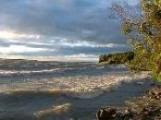Environmental groups praise lake act
A coalition of environmental groups, ratepayer and citizens’ groups is praising the McGuinty government’s announcement of plans to introduce the Lake Simcoe Protection Act.
The surprise announcement was made on July 6 at the Lake Simcoe Summit in Barrie in front of a cheering crowd representing 65 citizens’ and non-profit groups from around the lake, and 12 government agencies and elected officials.
“The proposed Act is better than a cool dip in the lake on a hot day,” said David Donnelly, counsel to Environmental Defence and to a number of the groups in attendance, and one of the first proponents of the Act.
“All our work to establish a truly great coalition and plan to save the lake is rewarded with this proposed Act,” said Robert Eisenberg, founding chairperson of the Rescue Lake Simcoe Coalition.
“There’s no going back now; the Government of Ontario has recognized the urgent need for an Act and so should everyone else.”
In his announcement, Premier Dalton McGuinty covered all the principles of conservation that Campaign Lake Simcoe hoped would form the foundation of an Act.
Describing the Act, the Premier told the crowd: “It will mean that no new development will be allowed to harm the lake. It will set strict limits on pollutants such as phosphorus. It will require stringent sewage treatment. It will support a governance structure that has been recommended by the Lake Simcoe Environmental Management Strategy working group. And it will promote recreation while protecting the health of the lake. We want growth that is good for the lake and the community that depends on the lake.”
“We are so glad that the Premier has listened to the science showing the damage Lake Simcoe has undergone,” said Wendy Francis, Director of Conservation and Science for Ontario Nature.
Lake Simcoe’s southeast shoreline is governed by the Greenbelt Act, leaving about half of the watershed unprotected. Simcoe County has been referred to as Ontario’s “Wild West” of development, with dozens of development applications leap-frogging over the Greenbelt and into south Simcoe County.
McGuinty said the new act would not impact development projects already underway, such as the Big Bay Point project in Innisfil.
The Greenbelt Protection Act contained retroactive provisions to catch developments that were not yet approved at the time the Act was announced. “The Greenbelt Protection Act is the logical starting point for a new Lake Simcoe Act,” said Donnelly. The proposed Lake Simcoe Protection Act is different from the Greenbelt Act in that it emphasizes tougher environmental assessment standards to ensure water quality in addition to new land use controls.
“While we greatly appreciated the announcement of the proposed Act, we are still concerned about the Big Bay Point development,” said Annabel Slaight, a founder and director of the Ladies of the Lake.
“There is so little understanding about the impact of large numbers of people and boats on our fragile lake, we believe that we need this knowledge, then policy about it, before a huge project like this goes forward.”
However, last week Simcoe County said Big Bay Point resort would assist in protecting Lake Simcoe and support the province’s proposed Lake Simcoe Protection Act. The act is designed to restore and protect the watersheds of the rivers that flow into Lake Simcoe.
Simcoe County’s corporate services manager Rick Newlove said phosphorous run-off puts the lake at risk. Phosphorous results from agricultural runoff, as well as from detergents, shampoo and toothpaste residues.
In extending servicing into Big Bay Point, developer Geranium Corporation will assist as many as 1,600 homeowners to connect to municipal services – and get them off septic systems, which are not sustainable in the long term, he explained.
“They’re getting people off septics and getting people connected (to municipal services), which will help the lake in the long run. We all know septic systems are not reliable in the long-term,” he said.
Further, he said, Geranium has had to meet some of the most stringent standards in Ontario.
“They’ve met the provincial, the county’s and the town’s criteria, (done) anything we’ve asked. They’ve worked to ensure the environment is protected and worked diligently to meet government requirements.
“With the Big Bay Point Resort, the province wouldn’t have signed off if they weren’t satisfied everything possible had been done to protect the environment,” he said.



